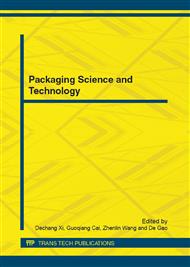p.167
p.171
p.175
p.180
p.186
p.190
p.194
p.199
p.203
Effects of Nano-SiO2 and Polyhedral Oligomeric Silsesquioxanes (POSS) Reagent on the Properties of Biodegradable Aliphatic-Aromatic Copolyesters
Abstract:
Biodegradable aliphatic-aromatic copolyesters nanocomposites were designed and prepared via direct melt polycondensation of terephthalic acid (TPA), 1,4-butanediol (BDO), poly(L-lactic acid) oligomer (OLLA) and nano-SiO2 or nanostructured cage POSS reagent (POSS). The morphologies and dispersions of two nanofillers and their comparative effects on the mechanical properties of the nanocomposites were investigated. TEM characterizations confirmed that both nano-SiO2 and POSS took good dispersions in the copolyesters matrix. Due to the presence of flexible PEG tails and inorganic-organic nanocaged hybrid structures, POSS showed rather better dispersions and formed more strong interactions with the matrix than nano-SiO2. The experimental results indicated that incorporation of nano-SiO2 or POSS-PEG was a simple and rather effective way to greatly enhance the mechanical and thermal properties of the nanocomposites. Comparative studies of the effects between nano-SiO2 and POSS demonstrated that the introduction of POSS-PEG not only remarkably improved the tensile strength from 6.4 MPa to 11.2 MPa and Young’s modulus from 9.6 MPa to 70.7 MPa, but also dramatically increased the elongation at break from 190 % to 350%.
Info:
Periodical:
Pages:
186-189
Citation:
Online since:
October 2012
Authors:
Price:
Сopyright:
© 2012 Trans Tech Publications Ltd. All Rights Reserved
Share:
Citation:


